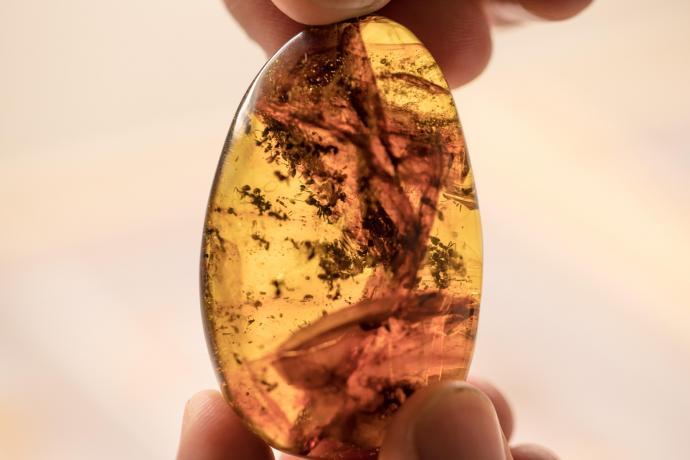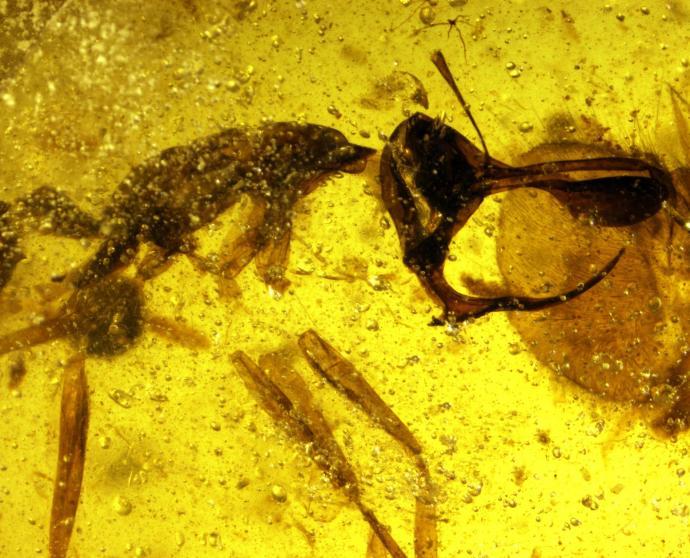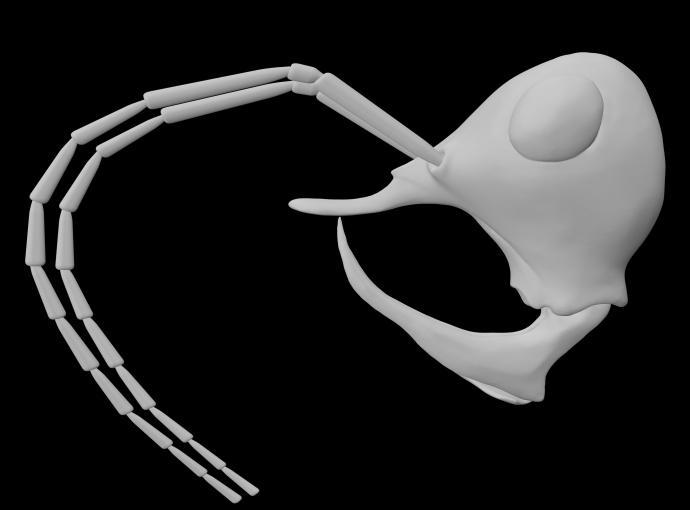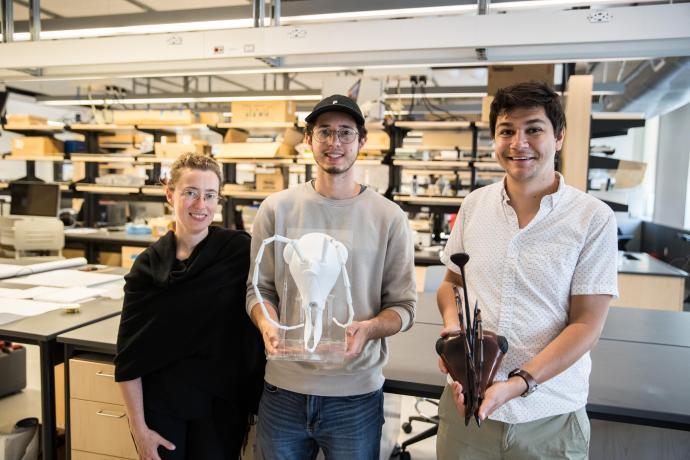Ants. Sure, most are harmless and inconspicuous. Though, there are always exceptions. Army ants, bulldog ants, and fire ants are a few living members of the family Formicidae that nature television viewers might recognize from any number of the World’s Deadliest countdown shows that populate the airwaves these days. However, one of the most fearsome and striking of any ant species to come about, since the insect’s evolution from their wasp-like ancestors nearly 140 million years ago, is a species of long-extinct “hell ants” (haidomyrmecine), now known as “Vlad the Impaler” (Linguamyrmex vladi).
Named after the infamous Wallachian ruler from the 1400s that inspired Bram Stoker’s Dracula, the prehistoric ant possessed scythe-like mandibles and a metal-reinforced horn on its forehead — deadly features that scientists believe the insect once used to gruesomely skewer its prey and consume their liquid innards in vampire-like fashion.

Vlad the Impaler lived on Earth almost 100 million years ago during the late Cretaceous Period. However, it wasn’t until 2017 that a team of evolutionary biologists, led by NJIT Professor of Biological Sciences Phillip Barden, discovered the hell ant and its unique head structure encased in Burmese amber from Kachin State, Myanmar.
The amber preserving Vlad’s fossil is estimated to predate the existence of Tyrannosaurus rex by nearly 35 million years. Now, Barden is leading a new project — to bring Vlad the Impaler and its long-extinct relatives back to life — digitally of course.
With Barden’s unique laboratory collection of prehistoric ant fossils at their disposal, an interdisciplinary team of NJIT students and faculty has begun applying modern imaging and design technology to virtually reconstruct the ancient anatomy of Vlad and its relatives — providing some of the first detailed, 3D models that illustrate how these long-lost insects once used their distinct biological traits to make them successful predators of their day. Barden said:
“The fossil record for ants as social insects starts about 100 million years ago with Vlad and others, which featured elongated metal horns and a lot of bizarre adaptations we no longer see today.
“Since the discovery of Vlad, we’ve found even more new and unusual species from this period and we want a way to highlight this diversity for future publications and for the public.
“When you are working with ants from the time of dinosaurs that look like actual monsters, like we are, it can be a great way to generate curiosity about science.”
Ants in amber: Unlocking a time capsule of Earth history

Vlad the Impaler is just one of several prehistoric ants that the NJIT team has planned to reconstruct, including six from the hell ant lineage — a class of ant best characterized by its mammoth-like mandibles that tusk up toward the head, which is a bygone anatomical trait among today’s insects. Barden said:
“There was a major initial adaptive radiation of diversity in ants 100 million years ago, but we lose all this rich diversity around the end of the Cretaceous period when non-avian dinosaurs begin to drop out of existence.
“An overarching goal we are working toward is solving the puzzle of this massive extinction involving the earliest social insects.

Barden added:
“These ant species are data points to help us learn more… Our ability to visualize and assess this ancient diversity means that we are widening our sampling pool for understanding patterns involved in the evolution of life.
“It might seem more art than science, but creating reconstructions of organisms like these has been the way we’ve learned about diversity, both past and present, dating back to Darwin.”
As part of the project, Barden’s lab has conducted X-ray computed tomography (CT) images of the amber-preserved ants to begin gathering details about their morphology and biomechanics.

His lab has also struck a collaboration with Distinguished Professor of Physics John Federici, who is applying an up-and-coming imaging technology — called terahertz time-domain spectroscopy — to identify in sub-millimeter resolution elements of the ants’ prehistoric environment and microhabitat that have been locked away within the amber, formed by tree resin that has fossilized over millions of years. Barden said:
“Amber can be an amazing window into the past, and the tools we now bring to bear on this material can really open up the field.
“Liquids and gas can be trapped inside, allowing us to ask questions about the atmospheric composition of the Earth 100 million years ago.
“Ants and other small organisms can be preserved inside and essentially frozen in time, containing physiological elements that reveal new details about ancient ecosystems or evolution on Earth more broadly.”
Federici added:
“What is exciting is that we are the first group to apply this relatively new technology in the field of paleontology to explore these fossilized samples in such detail.
“Already, we have been able to identify the presence of cracks, bubbles, termites, and vegetation trapped in the amber.
“There are a lot of potential implications this type of imaging system could have in paleontology, both in terms of what it may be able to capture, and the speed at which it can screen samples to find something interesting.”
Raising hell ants to life

At NJIT’s Idea Factory under the supervision of Associate Professor of Architecture Martina Decker, industrial design undergraduate students — Daniel Meza, Jackson Fordham, Oliver Budd, and Victor Nzegwu — have been hired through a university SEED grant to digitally reconstruct the head, antennae, and jaw structures of extinct ant species based on CT scan images and photomicrographs taken of ant fossils.

The team’s work has involved importing those raw fossil image files into 3D modeling software such as Blender, where they then sculpt fresh 3D models of the insects using the X-ray images and other media as rough templates for their design. Meza said:
“One of the best parts of this project has been getting an initial introduction to these ants and seeing the amazing photos and 3D scans of them trapped in amber.”
Fordham added:
“It’s been really memorable working in this type of collaborative environment on such a cool and unique project.
“As a group, we adopted an effective workflow of starting with reference images to begin editing the models, while constantly reviewing the updates with Dr. Barden until the models are completed… We’ve enjoyed the entire process.”

Decker said:
“It is exciting to go through all these different data sets, images, and drawings to paint a better picture of these ants.
“Some of the fossils almost looked like they had been exploded in little bits and pieces within the amber, so there has been a constant back-and-forth between different types of media to build the models.”
Barden explained:
“You can think of the CT scans of these fossils almost as a wireframe that we are building from.
“We have rotating fossil scans imported into the software, and we can sculpt the model next to it, side-by-side, by clicking and dragging a digital ball of clay to change or match the shape and proportions.
“When we produce these models, we can animate them and import them into other software to change things like muscle tension and recreate the biomechanics of these animals.”
The team has transferred their digital designs into 3D-printed physical models to show the general public as well — incorporating materials such as resin, silicone, and other industrial products to augment their printed designs and create museum-quality castes.
Already, the team’s models have made their way from display at NJIT’s Littman Library to audiences at museums across the tri-state area, recently appearing at the American Museum of Natural History and the Intrepid Sea, Air, and Space Museum for “Kid’s Week” earlier this year. Christine Sosiak, a Ph.D. researcher at Barden’s lab who is helping lead public outreach for the project, said:
“The reception [at the Intrepid] was tremendous.
“We met hundreds of kids and parents at our display who were extremely enthusiastic about these ants and asked wonderful questions… Our hope is to continue conducting these outreach events to teach people about entomology, paleontology, and evolution, as well as reach many more kids that may like insects and fossils, but have no idea that it’s a viable career.”
Decker’s team now says that its next venture will be to help create motorized models that help bring the prehistoric ants to life even more for audiences. Meza noted:
“We want to integrate motors into the models to showcase the movement of their mandibles especially.”
Federici’s lab has been issued a new grant from the U.S. Army Research Office to upgrade his lab’s terahertz imaging system for military research on materials characterization and nondestructive evaluation of 3D-printed materials. He plans to use the new system to isolate and capture new images of amber fossils in unprecedented detail.

Barden, meanwhile, has been traveling the world in search of new ant species. His lab is now characterizing a number of newly found species from the same deposit site that yielded Vlad the Impaler, as well as species from sites in India, the Dominican Republic, and even locally in New Jersey. Stay tuned. Barden said:
“We are describing a number of never-seen-before species, including one with bifurcated horns and serrated teeth that looks like it has a chain saw for a head…It’s unreal.
“There is a ton of amber material that we have to analyze from these deposit sites, so there are certainly more species coming and more models to make.”
Provided by: New Jersey Institute of Technology [Note: Materials may be edited for content and length.]







